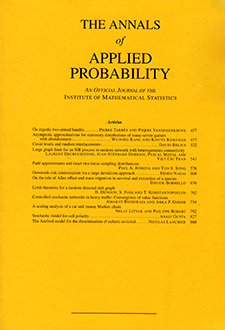Abstract
We study mixing times of the symmetric and asymmetric simple exclusion process on the segment where particles are allowed to enter and exit at the endpoints. We consider different regimes depending on the entering and exiting rates as well as on the rates in the bulk, and show that the process exhibits pre-cutoff and in some cases cutoff. Our main contribution is to study mixing times for the asymmetric simple exclusion process with open boundaries. We show that the order of the mixing time can be linear or exponential in the size of the segment depending on the choice of the boundary parameters, proving a strikingly different (and richer) behavior for the simple exclusion process with open boundaries than for the process on the closed segment. Our arguments combine coupling, second class particle and censoring techniques with current estimates. A novel idea is the use of multi-species particle arguments, where the particles only obey a partial ordering.
Funding Statement
The second author was partially supported by EPSRC Grant EP/R022615/1 and NSF Grant DMS-2052659.
The third author acknowledges the TopMath program and the Studienstiftung des deutschen Volkes for financial support.
Acknowledgments
We thank Noam Berger, Ivan Corwin, David Criens, Hubert Lacoin, Allan Sly, Herbert Spohn and Lauren Williams for helpful discussions and comments. We are indebted to the anonymous referee for a careful reading and pointing out several inaccuracies. This project was started at Cambridge University and carried out during visits of the authors at Princeton University and Technical University of Munich. We thank all three institutions for their hospitality.
Citation
Nina Gantert. Evita Nestoridi. Dominik Schmid. "Mixing times for the simple exclusion process with open boundaries." Ann. Appl. Probab. 33 (2) 1172 - 1212, April 2023. https://doi.org/10.1214/22-AAP1839
Information





